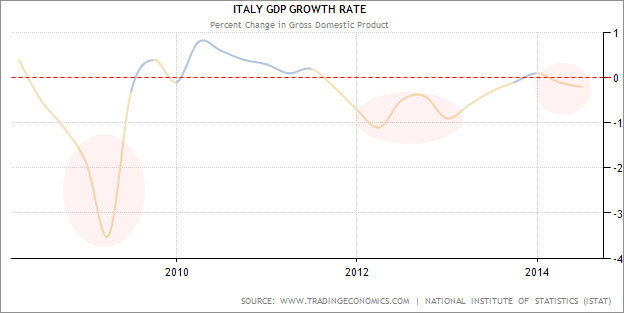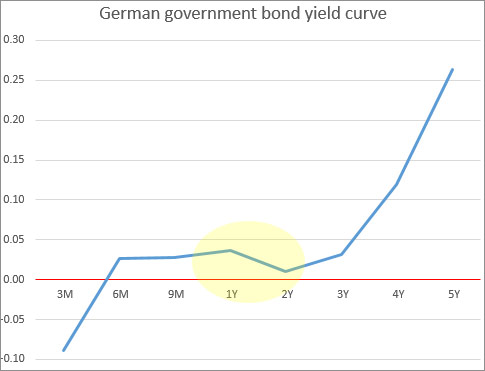A slew of negative economic surprises across the Eurozone is pointing to significant challenges the area faces on its road to recovery. Three of these surprises are listed below:
1. Italy's GDP unexpectedly contracted last quarter putting the nation into a third recession in since the financial crisis.
WSJ: — Italy has slipped into its third recession since 2008, data showed Wednesday, in an unexpected setback that threatens to restrain the broader euro zone's fitful recovery.
Italy's economy contracted at an annualized rate of 0.8% in the quarter ending June 30, according to a first estimate by national statistics institute Istat—the latest sign of how parts of Europe are still struggling to escape the legacy of the global financial crisis. It was the second successive quarter of falling Italian output, which meets the common international definition of a recession.
2. The area's retail sector took an unexpected turn for the worse last month.
Markit: — The eurozone retail sector started the second half of the year on a weaker footing. The fragility of consumer spending was exposed by the PMI, particularly in France and Italy where the data showed sharper downturns in sales. Even in Germany, the one area of relative strength, there was an appreciable slowdown from June’s recent peak. Retailers underperformed relative to their targets to the greatest extent since March 2013, leading to further accumulations of unsold stock and the prospect of greater discounting ahead.
3. German factory orders contracted at the fastest pace since 2011.
Deutsche Welle: — German industrial orders fell for the second consecutive month in June at a rate of 3.2 percent, following a similar 1.6 percent contraction in May, the economics ministry in Berlin said Wednesday. According to the data, orders contracted at their fastest pace since September 2011, disappointing analysts who had predicted gains of 0.9 percent in a consensus forecast.
While many are blaming these economic headwinds on the uncertainty related to Russia/Ukraine as well as the sanctions, some analysts are pointing to problems closer to home.
The Telegraph: — After what was dismissed as an irregular drop last month, Germany’s factory orders have seen another surprise fall in June. But the downturn has not been solely down to German exposure to ongoing tensions in Russia and Ukraine. Much of the poor performance is explained by crumbling demand from eurozone peers. Evelyn Herrmann, European economist at BNP Paribas, said that “the weakness was mainly driven by orders from within the eurozone” which fell by 10.4pc in June. Non-eurozone orders were stagnant in that month.
The collapse in German government bond yields accelerated in response, reaching another record low.
Moreover, the yield curve is beginning to show signs of inversion in the front end. This is not what the yield curve of a healthy economy is supposed to look like.
The so-called "Putin factor" has certainly shaken confidence of the area's consumers and added uncertainty to the corporate boardrooms (giving Putin additional leverage over western nations). But the Eurozone's challenges seem to go beyond that. As the ECB prepares for another meeting shortly, these issues are sure to be brought up. Draghi's last bullet - direct asset purchases by the ECB — may no longer be as easily dismissed by the Governing Council.
Related:
Satyajit Das: "Poker Bluff" - The European Economic Crisis Hasn't Gone Away











